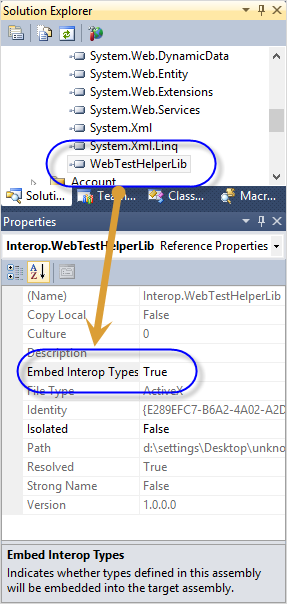C# COM 개체를 PIA(Primary Interop Assembly)로써 "Embed Interop Types" 참조하는 방법
인터페이스의 경우 다른 프로젝트에서 참조할 때 "Embed Interop Types"를 이용하면 DLL 의존성 없이 인터페이스 정의만 가져오는 것이 허용됩니다. 보통 Office 계열의 COM 개체를 다룰 때 사용하지만 C# 프로젝트에서도 이를 사용하는 것이 가능한데요.
간단하게 예를 들어 볼까요?
우선, 인터페이스 정의만 담은 DLL을 하나 생성하고,
// ClassLibrary1 프로젝트
using System;
using System.Runtime.InteropServices;
namespace ClassLibrary1
{
[ComVisible(true)]
[Guid("62A4A0A9-8791-444B-ABF7-8BFD23DFF0FB")]
[InterfaceType(ComInterfaceType.InterfaceIsDual)]
public interface IAdminCode
{
void SetRegistryValue();
}
}
이것을 상속받아 구현한 C# COM 개체를 다음과 같이 별도의 프로젝트에 만들었을 때,
// ClassLibrary2 프로젝트
using ClassLibrary1;
using System;
using System.Runtime.InteropServices;
using System.Windows.Forms;
namespace ClassLibrary2
{
[ComVisible(true)]
[Guid("296A7E30-8592-4EE5-8FE1-E9DAF86D146E")]
[ClassInterface(ClassInterfaceType.AutoDual)]
public class Class1 : IAdminCode
{
public void SetRegistryValue()
{
MessageBox.Show("TEST");
}
}
}
일반적으로는 IAdminCode 인터페이스를 담고 있는 ClassLibrary1.dll도 함께 배포를 해야만 정상적인 동작을 합니다. 하지만, PIA(Primary Interop Assembly)를 이용하면 ClassLibrary1.dll에 대한 의존성을 끊을 수 있습니다. 이를 위해, ClassLibrary2에서 ClassLibrary1을 "Embed Interop Types" == "True"로 두면 되는데,
[
ASP.NET에서 Server.CreateObject와 COM Interop 클래스 생성의 차이점]

현재 단계에서는 저렇게 설정하면 다음과 같은 CS1759 오류가 발생합니다.
Cannot embed interop types from assembly 'ClassLibrary1, Version=1.0.0.0, Culture=neutral, PublicKeyToken=null' because it is missing either the 'System.Runtime.InteropServices.ImportedFromTypeLibAttribute' attribute or the 'System.Runtime.InteropServices.PrimaryInteropAssemblyAttribute' attribute.
왜냐하면, 우리가 만든 ClassLibrary1.dll은 "Primary Interop Assembly"가 아니기 때문입니다. 당연히 저 오류를 없애려면 DLL을 PIA로 만들어야 하는데, 그 방법은 오류 메시지에도 나오듯이 PIA 특성을 해당 DLL에 부여하면 됩니다. 따라서, ClassLibrary1.dll 프로젝트의 AssemblyInfo.cs에 다음과 같이 PIA 특성을 추가합니다.
[assembly: PrimaryInteropAssemblyAttribute(1, 0)]
하지만, 일단 저렇게 해서 ClassLibrary1.dll을 PIA로 인식시킬 수는 있지만 이번에는 CS1756 오류 메시지가 발생합니다.
CS1756 Interop type 'IAdminCode' cannot be embedded because it is missing the required 'System.Runtime.InteropServices.ComImportAttribute' attribute.
메시지에 나오는 것처럼, 의존성 없는 Import를 원하는 인터페이스에 대해 ComImport 특성을 부여해야 합니다.
using System;
using System.Runtime.InteropServices;
namespace ClassLibrary1
{
[ComVisible(true)]
[Guid("23172f2f-a3d3-4180-97ae-7805f74a5a46")]
[InterfaceType(ComInterfaceType.InterfaceIsDual)]
[ComImportAttribute()]
public interface IAdminCode
{
void SetRegistryValue();
}
}
여기까지 해서 빌드하면 정상적으로 PIA와 그것을 참조하는 측에서 "Embed Interop Types" 옵션을 사용해 DLL 의존성을 끊을 수 있습니다.
이에 더해 ConsoleApp1.exe 프로젝트를 만들어, 마찬가지로 ClassLibrary1.dll에 대해 "Embed Interop Types" 참조를 하고 다음과 같이 ClassLibrary2.dll에서 제공하는 C# COM 개체를 아무런 의존성 없이 사용할 수 있습니다.
using ClassLibrary1;
using System;
namespace ConsoleApp1
{
class Program
{
static void Main(string[] args)
{
Guid guid = new Guid("{296A7E30-8592-4EE5-8FE1-E9DAF86D146E}");
Type type = Type.GetTypeFromCLSID(guid);
object comObject = Activator.CreateInstance(type);
IAdminCode ac = comObject as IAdminCode;
ac.SetRegistryValue();
}
}
}
IAdminCode 사용을 위해 ClassLibrary1.dll을 참조하지만 "Embed Interop Types" 옵션을 켰으므로 응용 프로그램 배포 시에는 ConsoleApp1.exe 파일과 해당 C# COM 개체를 포함한 ClassLibrary2.dll만을 배포해 동작시키는 것이 가능합니다.
참고로, 위의 예제에서는 인터페이스와 구현을 각각 ClassLibrary1, ClassLibrary2 프로젝트에 분리했는데요. 그냥 하나로 합쳐도 무방합니다. 즉, IAdminCode 인터페이스를 ClassLibrary2 프로젝트에 추가한 다음 ConsoleApp1에서는 ClassLibrary2 프로젝트를 PIA 참조해도 상관없습니다.
첨부 파일은 2개의 프로젝트를 포함하는데, 각각 "ClassLibrary1, ClassLibrary2, ConsoleApp1"로 나뉜 것과 "ClassLibrary2, ConsoleApp1"로 나뉜 것을 포함합니다.
[이 글에 대해서 여러분들과 의견을 공유하고 싶습니다. 틀리거나 미흡한 부분 또는 의문 사항이 있으시면 언제든 댓글 남겨주십시오.]